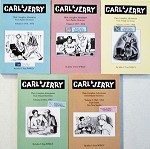Carl and Jerry: El Torero Electronico
|
|||||||
"So if I can work out a really efficient way of changing part of this wasted noise into electrical energy, it can be charging batteries and taking some of the load off the plane's generating plant." That passage, from the April 1960 Carl and Jerry adventure story, reads like a modern day energy harvesting project. Each month Popular Electronics included an electronics saga that normally included some high tech sleuthing by the teenagers a la the Hardy Boys. This is a particular favorite of mine because it involves a radio controlled airplane model. BTW, according to the Google translator, the title of this story is "The Electronic Bull." Carl and Jerry: El Torero Electronico By John T. Frye, W9EGV
"What are you doing?" Carl shouted. "This is no day to be messing around indoors. Spring is busting out all over out there. And shut off that blasted noise!" Obediently Jerry reached out and shut off the sine-wave generator connected to the input of the hi-fi amplifier. "I'm experimenting with converting sound energy into electrical energy," he explained. "Look at this sound level chart that appeared in the February 1959 issue of Electronics World and at this one prepared by Bell Telephone Laboratories. See: the audio power in peak sounds from a seventy-five piece orchestra is 65 watts. The sound of an ordinary airplane at eighteen feet is better than 20 db, or 100 times more powerful; so it must put out close to 6500 watts of sound. Think how much more sound power is put out by one of those six-engine jets at the air base. When they take off, you can't hear yourself think." "So-o-o-o ?" "So if I can work out a really efficient way of changing part of this wasted noise into electrical energy, it can be charging batteries and taking some of the load off the plane's generating plant." "How're you starting out?"
"This transducer I'm trying first is a sound-powered phone. As you can see, it's mounted exactly a foot away from the speaker and directly in front of it. These sound-powered phones arc designed to be transducers of sound into electrical energy and electrical energy into sound. When two of the units are connected together, sound striking the diaphragm of either moves an attached coil in a strong magnetic field, producing currents in the coil. These induced currents travel along the connecting wires and flow through the coil of the other unit, causing it to vibrate its diaphragm and produce sound again. Notice that all the power used - and you can carry on conversations up to twelve miles with a pair of these phones - is produced by sound waves. "Any other transducers I use, such as sound-powered units working on a slightly different variable-reluctance principle, speakers, crystal units, etc., will be mounted in the same position as this moving-coil unit. They will be subjected to the same dynes per cm2 of sound power as long as I keep one watt of 1000-cycle tone feeding into the speaker. This will allow me to compare relative efficiencies by simply taking into account the pickup area of my transducer and noting the electrical power developed across a resistive load. Of course, impedances between the transducer and the load must be carefully matched to develop maximum power. That's what I'm doing now." "Sounds like a real neat idea, but let's save it for a rainy day," Carl suggested. "Come along and help me tryout my brand-new radio-controlled plane. The thermometer is up to 75 out there, and the buds are bursting like popcorn." Jerry needed little urging, and a half hour later the boys were parking their bicycles along a narrow dirt road running alongside a large pasture with a single tree growing in the center of it. Carl's plane was not a sleek modern aircraft. Instead, it was a sturdy old-fashioned biplane model of the sort he had seen crop-dusters using in the South. The large wing area permitted it to stay in the air at slow speed, and an oversize engine gave it lots of power for hedge-hopping tactics. Carl had spent a great deal of time - and no little money - designing the most responsive and complete remote control possible for maximum maneuverability. It was his intention to fit a smoke emitter in the plane and give a realistic demonstration of dusting procedures at a model airplane meeting coming up in a couple of months.
"What a sweet-flying job!" he chortled happily. "Watch this, old buddy; watch me put it in a tight circle around that tree." The little plane lifted easily to the top of the tree and went into a tight banked left turn. At this moment there was a terrific rumbling roar right in the boys' ears, and Carl was so startled that he dropped the control box. Standing in front of the boys, with only the fence between, was a red-eyed black bull emitting a low earth-shaking bellow through his flared nostrils. "Wow!" Jerry exclaimed shakily; "what a beast! I'm sure glad that fence is there. He must have sneaked up on us while we were watching the plane." "Where is the plane?" Carl asked as he snatched up the control box and anxiously scanned the empty sky. "Oh, oh! he groaned. "There it is in the tree." Sure enough, the little plane was resting in the upper branches of the tree with its motor still snarling away. Carl cut the motor off with the control box, and the two boys tried to drive the huge animal away by shouting at him and waving their arms. But this only seemed to add to the bull's ill temper. Finally they went down the road a short distance and hid in the side-ditch.
The tree was a lot closer than the fence, and both boys started to climb it simultaneously. Since the trunk was only about a foot in diameter, this caused some confusion. They made it up to the branches, though, and as they sat there, breathing hard and staring down at the bellowing animal below, Jerry said bitterly: "You and your superior muscles! What's the big idea of climbing over the top of me? If there's one thing I can't stand, it's a show-off!" "I didn't mean to climb over the top of you; I had help from the bull," Carl explained, tenderly rubbing the area of his hip pocket. "I was having a little trouble climbing, though, with you standing on my face. I'm going up to get the plane. You keep Ferdinand entertained." In a few minutes Carl had inched his way back down to Jerry's level with the plane in his hands. "Not hurt a bit!" he gloated. "When I dropped the control box, the plane must have pulled up in a stall and then pancaked into the tree. We're lucky." "Oh, we're lucky, all right!" Jerry exclaimed sarcastically. "We have a choice: we can either sit up here in this tree and freeze to death tonight or we can let that bull make shish kebab out of us on his horns." "It's not that bad - I hope," Carl comforted. "We'll get out of this some way. He'll get tired after a while and wander away. Let's be quiet and see if he doesn't forget us." The boys remained absolutely still for half an hour, but the bull did not calm down. He circled around and around the tree, pawing the earth and throwing great clods of soft turf up over his back while slobbers ran from his bellowing mouth. "Gee, what a grouch!" Carl finally exclaimed as he looked anxiously at the sun touching the horizon. "I never realized what 'bull-headed' really meant until now. He's not going to cool off. We've got to think of something else." "You might jump out of the tree and sprint for the fence," Jerry suggested. "You're pretty fast and may be able to out-run him. While he's chasing you, I'll carry the plane to the fence on the other side of the pasture." Before Carl could answer, the bull thrust a sharp pointed horn into the trunk of the tree and ripped off a great slab of bark. "Let's think of another idea," Carl said as he tightened his grip on the quaking limbs. "What we really need is a toreador to coax him away from us." "That's it!" Jerry exclaimed: "an electronic toreador! You got any red cloth about you?" "I don't think so," Carl answered; "but if you think I'm going to get down there and wave a red flag in front of that couple of tons of pure cussedness, you've got another think coming." "That lining of your jacket is red silk," Jerry observed. "Take my pocket knife and cut out a chunk a couple of feet square." "Mom will kill me if I do." "Would your mother rather have a whole jacket or a son with a whole hide? Get with it while I unravel a sock to get a piece of strong thread. We'll fasten the piece of red cloth to the plane with about ten feet of thread. Then we'll make the plane drag the cloth back and forth in front of Ferdinand. If we're lucky, we may be able to coax him away from the tree long enough for us to reach the fence."
Carl worked the control box expertly, and the little plane came back toward the tree carrying the bright red cloth about three feet above the ground. The animal turned his great head toward the sound of the purring motor and spied the approaching red cloth. With a bellow of anger, he charged it. The plane went into a steep climb and carried the cloth out of reach; then it wheeled about and came back and actually dragged the bright fabric over the back of the startled bull. As it flipped off his horns in front of his eyes, he charged fiercely after it. Carl throttled the motor down until the plane was almost stalling and flew a zigzag course that kept the red cloth tantalizingly in front of the animal's nose until he was led into a far corner of pasture; then both boys leaped to ground and ran for the closest fence. Carl, as he ran, still kept an eye on the little plane and used the control box to keep it flying. The bull was so engrossed with his new "enemy" that he did not notice the boys' escape at all. When they were safely across the fence, Carl brought the little plane sailing to them. He handed the control box to Jerry and had him put the plane into a tight circle while he caught the dangling piece of red cloth and broke the thread; then he took over and brought the plane in for a smooth landing on the narrow dirt road. "Well," Jerry observed, getting astride his bicycle; "that's that, and we'd better be getting home or we'll miss supper." "Yeah," Carl agreed as he shot a malevolent look at the snorting bull, once more just on the other side of the fence; "and I just hope we have beefsteak!"
Posted May 30, 2019 |
|||||||

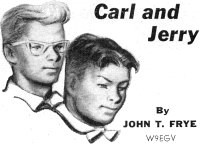 As Carl stepped through the open door of the
electronic laboratory he shared with his pal, Jerry, in the basement of the latter's
home, his ears were assailed by a loud, piercing, unwavering tone. It was coming
from a hi-fi speaker in one corner of the room, and Jerry was crouched over some
electronic equipment directly in front of the speaker.
As Carl stepped through the open door of the
electronic laboratory he shared with his pal, Jerry, in the basement of the latter's
home, his ears were assailed by a loud, piercing, unwavering tone. It was coming
from a hi-fi speaker in one corner of the room, and Jerry was crouched over some
electronic equipment directly in front of the speaker. 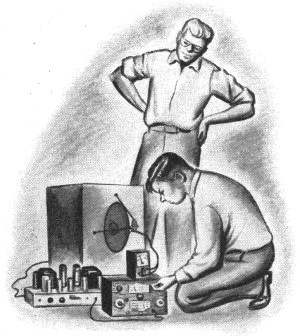 "I'm trying to find the most efficient device
for translating sound into electricity without worrying about the actual efficiency
percentage of the device. Measuring actual sound power is real tricky even when
you have elaborate sound-measuring equipment and a sound-deadened room. By measuring
the voltage developed across the eight-ohm voice coil of this speaker by my 1000-cycle
tone, I'm setting the electrical power fed into the speaker at exactly one watt.
I figure the speaker has an efficiency of between five and ten percent; so I estimate
that the sound power output is only around one-fifteenth of a watt or thereabouts.
"I'm trying to find the most efficient device
for translating sound into electricity without worrying about the actual efficiency
percentage of the device. Measuring actual sound power is real tricky even when
you have elaborate sound-measuring equipment and a sound-deadened room. By measuring
the voltage developed across the eight-ohm voice coil of this speaker by my 1000-cycle
tone, I'm setting the electrical power fed into the speaker at exactly one watt.
I figure the speaker has an efficiency of between five and ten percent; so I estimate
that the sound power output is only around one-fifteenth of a watt or thereabouts.
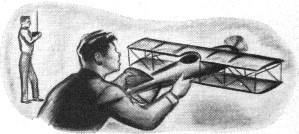 Carl handled the controls, and Jerry hand-launched
the plane. Right from the start it performed beautifully. Carl first sent it high
above the pasture to test it out; but when he saw how quickly and smoothly it answered
every electronic command, he brought it down until it was skimming only a few feet
above the fresh green sod.
Carl handled the controls, and Jerry hand-launched
the plane. Right from the start it performed beautifully. Carl first sent it high
above the pasture to test it out; but when he saw how quickly and smoothly it answered
every electronic command, he brought it down until it was skimming only a few feet
above the fresh green sod. 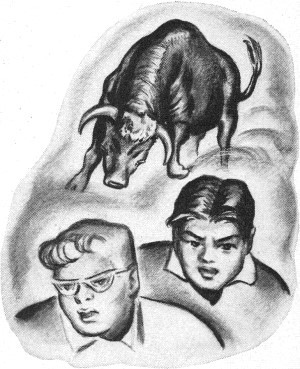 The bull eventually calmed down and wandered
over to the far side of the pasture. Stealthily Carl and Jerry crawled under the
barbed wire and quietly approached the tree. They were almost to it when the beast
spotted them. Its tail went up into the air, and it came in a lumbering run straight
for them.
The bull eventually calmed down and wandered
over to the far side of the pasture. Stealthily Carl and Jerry crawled under the
barbed wire and quietly approached the tree. They were almost to it when the beast
spotted them. Its tail went up into the air, and it came in a lumbering run straight
for them. 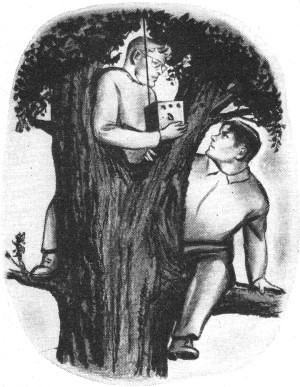 Carl butchered a large square of cloth from
the jacket lining and fastened it with the thread to the plane at a point where
the drag would have a minimum effect on the plane's maneuverability. Then Jerry
inched out on a limb until he could launch the plane in the clear. The motor was
started and, at a word from Carl, Jerry gave the little plane a strong push. For
an anxious moment it swooped down until the piece of cloth brushed the grass, but
then it started climbing and sailed around the pasture easily.
Carl butchered a large square of cloth from
the jacket lining and fastened it with the thread to the plane at a point where
the drag would have a minimum effect on the plane's maneuverability. Then Jerry
inched out on a limb until he could launch the plane in the clear. The motor was
started and, at a word from Carl, Jerry gave the little plane a strong push. For
an anxious moment it swooped down until the piece of cloth brushed the grass, but
then it started climbing and sailed around the pasture easily.  Carl & Jerry, by John T. Frye
Carl & Jerry, by John T. Frye